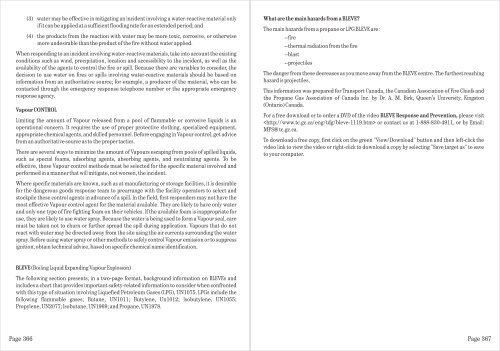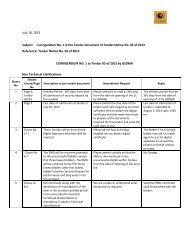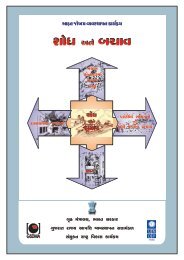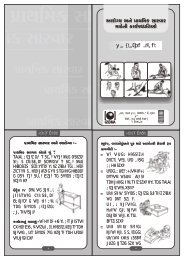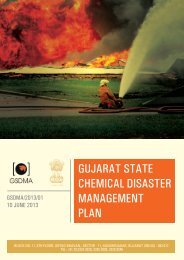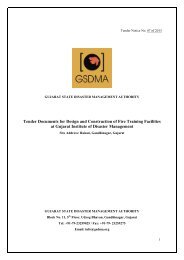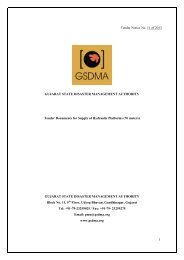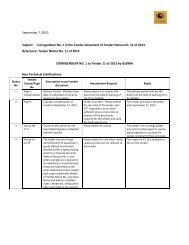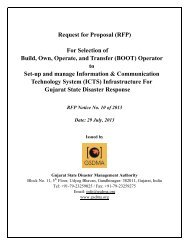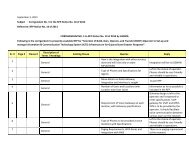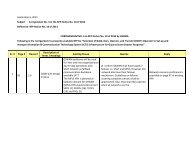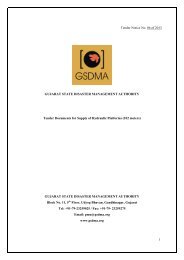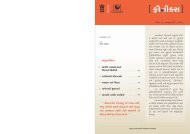Emergency Response Guidebook - Gujarat State Disaster ...
Emergency Response Guidebook - Gujarat State Disaster ...
Emergency Response Guidebook - Gujarat State Disaster ...
You also want an ePaper? Increase the reach of your titles
YUMPU automatically turns print PDFs into web optimized ePapers that Google loves.
(3) water may be effective in mitigating an incident involving a water-reactive material onlyif it can be applied at a sufficient flooding rate for an extended period; and(4) the products from the reaction with water may be more toxic, corrosive, or otherwisemore undesirable than the product of the fire without water applied.When responding to an incident involving water-reactive materials, take into account the existingconditions such as wind, precipitation, location and accessibility to the incident, as well as theavailability of the agents to control the fire or spill. Because there are variables to consider, thedecision to use water on fires or spills involving water-reactive materials should be based oninformation from an authoritative source; for example, a producer of the material, who can becontacted through the emergency response telephone number or the appropriate emergencyresponse agency.Vapour CONTROLLimiting the amount of Vapour released from a pool of flammable or corrosive liquids is anoperational concern. It requires the use of proper protective clothing, specialized equipment,appropriate chemical agents, and skilled personnel. Before engaging in Vapour control, get advicefrom an authoritative source as to the proper tactics.There are several ways to minimize the amount of Vapours escaping from pools of spilled liquids,such as special foams, adsorbing agents, absorbing agents, and neutralizing agents. To beeffective, these Vapour control methods must be selected for the specific material involved andperformed in a manner that will mitigate, not worsen, the incident.What are the main hazards from a BLEVE?The main hazards from a propane or LPG BLEVE are:--fire--thermal radiation from the fire--blast--projectilesThe danger from these decreases as you move away from the BLEVE centre. The furthest reachinghazard is projectiles.This information was prepared for Transport Canada, the Canadian Association of Fire Chiefs andthe Propane Gas Association of Canada Inc. by Dr. A. M. Birk, Queen’s University, Kingston(Ontario) Canada.For a free download or to order a DVD of the video BLEVE <strong>Response</strong> and Prevention, please visit or contact us at 1-888-830-4911, or by Email:MPS@tc.gc.ca.To download a free copy, first click on the green "View/Download" button and then left-click thevideo link to view the video or right-click to download a copy by selecting "Save target as" to saveto your computer.Where specific materials are known, such as at manufacturing or storage facilities, it is desirablefor the dangerous goods response team to prearrange with the facility operators to select andstockpile these control agents in advance of a spill. In the field, first responders may not have themost effective Vapour control agent for the material available. They are likely to have only waterand only one type of fire fighting foam on their vehicles. If the available foam is inappropriate foruse, they are likely to use water spray. Because the water is being used to form a Vapour seal, caremust be taken not to churn or further spread the spill during application. Vapours that do notreact with water may be directed away from the site using the air currents surrounding the waterspray. Before using water spray or other methods to safely control Vapour emission or to suppressignition, obtain technical advice, based on specific chemical name identification.BLEVE (Boiling Liquid Expanding Vapour Explosion)The following section presents, in a two-page format, background information on BLEVEs andincludes a chart that provides important safety-related information to consider when confrontedwith this type of situation involving Liquefied Petroleum Gases (LPG), UN1075. LPGs include thefollowing flammable gases; Butane, UN1011; Butylene, Un1012; Isobutylene, UN1055;Propylene, UN2077; Isobutane, UN1969; and Propane, UN1978.Page 366Page 367


